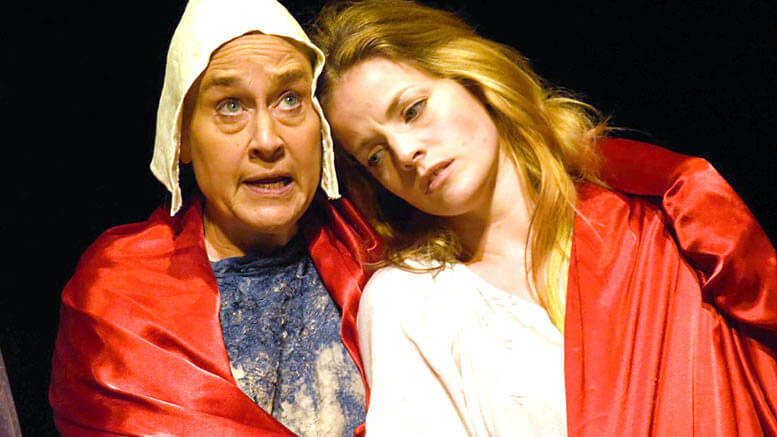The Life and Death of Queen Margaret is a new play that takes one of Shakespeare’s supporting characters and puts her at the helm of her own story.
The all-female dance-theater production plays at Theater for the New City August 10-20 in the Community Theater, Thursdays – Saturdays at 8 p.m. and 3 p.m.on Sundays. Tickets are available by clicking the Tix. link.
After a successful run in Western Massachusetts, ensemble Real Live Theatre makes its New York City debut with this show, telling the story of Queen Margaret of Anjou, a French woman who was married to King Henry VI and effectively became the ruler of England.
“We took Margaret’s skeleton from Shakespeare’s Henry VI and Richard III plays and fleshed her out , incorporating information from the life of the real historical figure, giving her motivation and a full arc,” said Toby Vera Bercovici, director and co-creator of the piece with Dan Morbyrne. “We created the play Shakespeare might have written had he been a woman. And we did it largely by using Shakespeare’s own language.”
Just as Tom Stoppard’s Rosencrantz and Guildenstern are Dead re-imagines Hamlet from a different point of view, The Life and Death of Queen Margaret seeks to recreate and reframe this famous Shakespearean character.
The production aims to free Margaret from her Shakespearean shackles, where she has long played a supporting role, to at last become the hero of her own story.
It does this by taking text from plays as varied as Much Ado About Nothing and The Tempest, and weaving it together in unlikely ways. What it does not tell through words, it shows through striking choreography.
Margaret’s story itself is nothing if not Shakespearean, the kind of life that could be fodder for film, television and the stage, at once tragic and majestic.
She was married to King Henry VI at the age of 15, as an attempt to heal the rift between England and France created during the 100 Years War.
“There are multiple reasons to do a play about Margaret,” said Bercovici. “For one thing, she speaks some of the most breathtaking language in all of the canon. However, it’s rarely heard, because it’s buried in three plays which are hardly ever performed. We wanted to liberate that language.”
If this play is in part about “liberation,” freeing a character from her supporting role in literature, Bercovici and Morbyrne want to liberate more than just the language. They also seek to revive one of history’s more fascinating figures.
“With all of the misogyny which surrounded Hillary Clinton’s campaign, and now with Trump’s presidency in a way legitimizing a lack of respect for women, it felt like an important feminist story to be told,” Bercovici continued. “The specter of Margaret has existed for hundreds of years, created by a man and framed as a villain. It’s time that changed.”
While using Shakespeare’s words in a kind of collage that retells Margaret’s life, this production portrays a woman caught in personal and political conflict after her husband falls ill and becomes unable to rule.
“We re-imagined her using Shakespeare’s own language,” said Bercovici, a visiting assistant professor of theater and dance at Colby College in Waterville, Maine. “We were clever and strategic about how we picked lines from different plays, and what we had to write ourselves, we wrote in iambic pentameter.”
Margaret of Anjou lived from 1430 to 1482, becoming Queen of England when she married King Henry VI and leading the Lancaster faction in the Wars of the Roses.
“King Henry VI, both historically and as Shakespeare has painted him, was a pacifist, very pious, quite prudish, and stepped back from public life, which is part of the reason that Margaret took the reins,” Bercovici said.
She sees this production as a way of telling Margaret’s story, complete with some information and perspective that Shakespeare may have omitted.
“What was true historically but was not present in the Shakespeare, but which we have added back into the mix, is that Henry inherited a familial madness and was catatonic for over a year,” Bercovici added. “This is why Margaret became a military and political leader. There was no protocol in place for what would happen if a living ruler became unable to govern. Margaret needed to protect England from the outside world, the House of Lancaster from the House of York, and her son’s right to the throne. So, she took control.”
After the house of Lancaster was defeated at Tewkesbury in 1475, Margaret was sent back to France, where she died, impoverished, at the age of 52.
Shakespeare must have been truly enamored of this character, because he keeps her in England rather than exiling her to France, and paints her as the prophetic madwoman in Richard III,” Bercovici said. “We feel the same way, equally enamored of both the literary character and the historical figure. Our story combines both women and rounds out the portrayal with a good dollop of our own imaginations.”
The Life and Death of Queen Margaret, Theater for the New City, 155 First Ave., NY, NY. August 10-20 Saturdays at 8 p.m. and 3 p.m. on Sundays. $18. 212-254-1109, Tickets are available by clicking this Tix. link. More info. and tickets at www.theaterforthenewcity.net.





